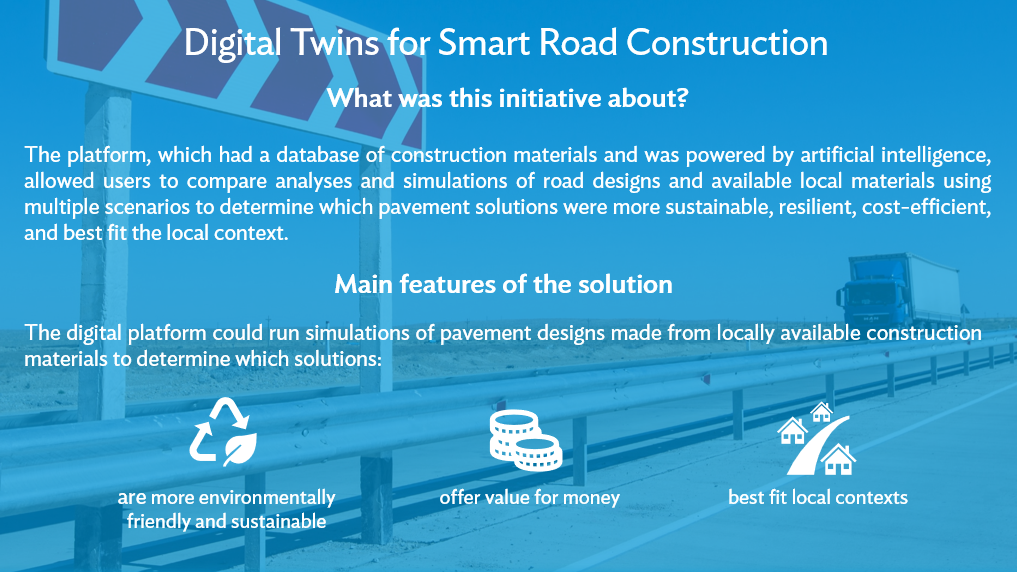Digital Twins for Smart Road Construction: Digital twin technology to improve sustainability in road construction
Start of implementation: 2021
Technology type: Artificial intelligence
Technology service provider: ORIS
ITD’s Partner ADB Department: Central and West Asia Department
In line with ADB’s Operational Priorities:
· Tackling climate change, building climate and disaster resilience, and enhancing environmental sustainability
o Mitigation of climate change increased
o Climate and disaster resilience built
o Environmental sustainability enhanced
· Promoting rural development and food security
o Rural development enhanced
· Fostering regional cooperation and integration
o Greater and higher quality connectivity between economies
· Strengthening governance and institutional capacity
o Strengthened country systems and standards
ADB supported the rehabilitation of the Central Asia Regional Economic Cooperation Corridor in Uzbekistan, including a 25-kilometer (km) section of Section 1 of Highway A380, located in the Republic of Karakalpakstan and one of the key trade routes in the region. The Digital Twins for Smart Road Construction initiative aimed to improve not just connectivity but also road conditions and safety. Using a climate-resilient and sustainable design was also important, especially considering that Uzbekistan is experiencing water scarcity. Road construction projects consume large amounts of natural resources and contribute to significant global emissions. Cement manufacturing alone produces 5%–8% of global anthropogenic greenhouse gas emissions. About 22% of global carbon dioxide emissions come from activities related to roadwork, including mining, transportation, and paving, as well as emissions from road users.
ADB’s Climate Change Operational Framework 2017–2030 supports the shift toward low greenhouse gas emissions and climate-resilient development. Therefore, a tool was needed that would support the shift toward environmentally friendly designs that provide value for money without compromising road safety and durability.
To this end, ADB engaged the technology service provider ORIS, which offers a digital platform capable of running simulations to compare how different materials used in pavement solutions would perform in certain traffic conditions and different environments, including the potential impacts of climate change. The platform enables users to consider which road designs are environmentally friendly solutions that best fit the unique contexts where the connective infrastructure would be constructed.
The technical service provider, in collaboration with ADB and the Government of Uzbekistan, conducted field research and surveyed the quarries and material producers near the project site to get information on the available materials (including water), suppliers, and corresponding costs. AI was also used to gather data on geography, construction materials, weather forecasts, and pavement solutions; and the carbon impact of the assessed materials was analyzed. Uzbekistan regulations and international road design standards were also gathered.
Multi-criteria analyses and evaluations were then performed to determine the best design options. Among the criteria that were considered were the material types and costs, projected carbon emissions, and durability and resilience of the roads given the projected level of road use and impacts of climate change. The option to recycle good quality materials from the existing roads, such as asphalt, crushed stones, and shoulder materials, to further reduce costs was also considered. The ORIS platform was then used to perform a pavement design analysis to compare three designs (base case design, French, and German) to identify improvement opportunities to lower costs, spare natural resources, and support the recycling of materials. The platform was also used to generate recommendations on maintenance, climate change and sustainability optimization, and road safety improvement. Forty years’ worth of data were also used to model how the road project is anticipated to experience the impacts of climate change, including heat, floods, and frost.
Two additional modules were integrated based on specific ADB requirements: a carbon dioxide calculator and data exchange on the road life cycle vehicle consumption. The old road safety standards were also updated, with over 10 normative documents and handbooks developed.
The improved design complied with United Nations (UN) global road safety performance targets for road construction. Analysis showed that using the improved road design reduced carbon emissions by 17% and natural resources use by 29%. Five million liters of water were saved, which is especially important for a water-scarce country such as Uzbekistan. Costs went down by 10%, which was equivalent to $3.2 million.
The analysis also showed that a $7.1-million investment in the project would make it exceed the minimum UN 3-star safety target, resulting in a 56% reduction of fatalities along that section.
These results were achieved while delivering the other benefits of road rehabilitation, including reducing travel time by 15% and supporting trade in the region.
The Digital Twins for Smart Road Construction initiative had a second phase, which covered the rehabilitation of a 4-km-long section of the 4R180 rural road in Uzbekistan and also incorporated climate-resilient design elements.
This initiative has shown that the digital twin platform can be used as a tool for due diligence. Its ability to conduct multi-criteria analyses can aid decision-makers in project implementation, including developing sustainable road designs. This is important given the growing challenges due to climate change. Other types of technology may also be considered in similar projects in the future. For example, drones and sensors may be used separately or alongside digital twins to further improve the monitoring of road conditions and durability.

